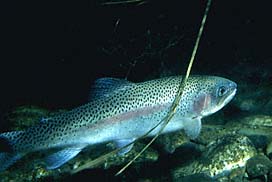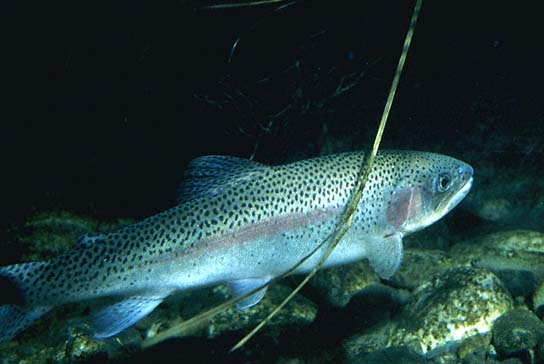Trouts and salmons
Description
To 3'9" (1.1 m); 42 1/8 lbs (19.1 kg). Elongate, fusiform. Marine coloration: metallic-blue above, silvery-white below, with small, black spots on back, sides, and dorsal and caudal fins. Freshwater coloration: spots more prominent, distinctive red band on sides. Mouth white; no teeth on back of tongue. 8-12 anal fin rays; adipose fin present, usually with black edge.
Endangered Status
Sea-run populations of the Rainbow Trout, known as Steelheads, are on the U.S. Endangered Species List. Certain naturally spawned populations in California and Washington are classified as endangered, and other naturally spawned populations in California, Idaho, Oregon, and Washington are classified as threatened. The populations of these and other trout and salmon have been declining for years because of habitat alteration caused by logging, diversion of water from the streams and rivers the fish spawn in, development along those waterways, pollution, and the building of hydroelectric dams. Removal of trees by loggers and developers exposes the streams to sunlight, often warming the water to lethal temperatures. Erosion from logging roads and from cleared lands fills the water with sediment, which can also make it uninhabitable; and runoff from rooftops, roadways, and parking lots contains substances that can contaminate the water. Conservation efforts have been opposed by logging, agricultural, and development interests.
Habitat
Inshore ocean at mid-depths and near surface; spawns in freshwater streams and rivers.
Range
From Bering Sea to S. California. In fresh water, native range confined to lakes and streams of western states bordering Pacific Ocean from Alaska to Baja California; introduced throughout Canada and United States in suitable streams and lakes.
Discussion
Sea-run Rainbow Trout usually spend 2 to 4 years in their home stream before venturing to sea, where they remain for about 3 years. They return to their home stream in the winter to spawn, and will continue this pattern as long as they survive natural predators. Fish that exist solely in fresh water spawn in the spring. Most males spawn at 1 year, while females may take 6 years to mature. Rainbow Trout are much-sought game fish; they are rarely taken at sea by bait anglers, but do succumb readily to trolled shrimplike flies. They provide good eating and are raised for market through aquaculture. There are small commercial gill-net fisheries north of Oregon for sea-run fish.


